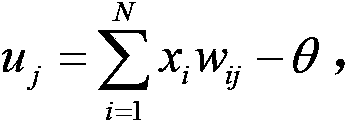Optical fiber simulated Raman scattering effect based optical neuron and establishment method thereof
A stimulated Raman scattering and neuron technology, applied in the field of optical communication, can solve problems such as dispersion, low fan-in and fan-out coefficients of electronic devices, and technical difficulties in electronic interconnection
- Summary
- Abstract
- Description
- Claims
- Application Information
AI Technical Summary
Problems solved by technology
Method used
Image
Examples
Embodiment 1
[0056] Such as figure 1 As shown, the optical neuron based on the stimulated Raman scattering effect in the optical fiber of the present invention includes (N-1) external optical transmitters 1 for emitting (N-1) signal lights, for emitting The first local optical transmitter 2 of the first local signal light, the second local transmitter 3 for emitting the second local signal light and the subtractor 4 for subtracting the electric signal, and for (N -1) A multiplexer 5 for coupling the (N-1) signal lights emitted by the external optical transmitter 1 and the first local signal light emitted by the first local optical transmitter 2, the first to (N-1) The output ends of each of the external optical transmitters 1 are respectively connected to the first to (N-1) input ends of the multiplexer 5 through (N-1) first optical fibers 6, and the first local optical transmitter The output end of the machine 2 is connected to the Nth input end of the multiplexer 5 through the second op...
Embodiment 2
[0061] The difference between this embodiment and Embodiment 1 is that the weights of the optical neurons can be positive or negative, and among the center wavelengths of (N-1) external optical transmitters 1, there are The central wavelengths of each are arranged in descending order and are all smaller than the central wavelength of the first local optical transmitter 2 in addition The central wavelengths of each are arranged in descending order and are all greater than the central wavelength of the first local optical transmitter 2 Wherein, N is an even number. The central wavelength of the first local optical transmitter 2 Satisfy the frequency shift calculation formula Δ υ 1 ‾ = ( 1 / λ ‾ 1 ) - ( 1 ...
PUM
 Login to View More
Login to View More Abstract
Description
Claims
Application Information
 Login to View More
Login to View More - R&D
- Intellectual Property
- Life Sciences
- Materials
- Tech Scout
- Unparalleled Data Quality
- Higher Quality Content
- 60% Fewer Hallucinations
Browse by: Latest US Patents, China's latest patents, Technical Efficacy Thesaurus, Application Domain, Technology Topic, Popular Technical Reports.
© 2025 PatSnap. All rights reserved.Legal|Privacy policy|Modern Slavery Act Transparency Statement|Sitemap|About US| Contact US: help@patsnap.com



